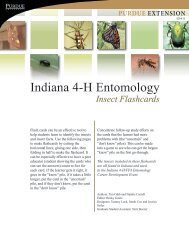Pink Gypsy Moth - aphis - US Department of Agriculture
Pink Gypsy Moth - aphis - US Department of Agriculture
Pink Gypsy Moth - aphis - US Department of Agriculture
You also want an ePaper? Increase the reach of your titles
YUMPU automatically turns print PDFs into web optimized ePapers that Google loves.
maximum and minimum diameters varying from 1 .13-1.19 mm and 0.86-0.92 mm<br />
respectively ” (Roonwal 1979b).<br />
“Egg-mass after hatching”<br />
After the majority <strong>of</strong> eggs have hatched, an egg mass presents a changed appearance.<br />
Firstly, the hair-covering which has hitherto (for several months in the case <strong>of</strong> the<br />
overwintering eggs) remained pure white, now becomes dull-coloured, a dirty cream,<br />
and, in a few cases, with irregular patches <strong>of</strong> pale buff. Secondly, the hair covering<br />
is pierced by numerous rounded holes <strong>of</strong> varying diameters (c. 0.5-3 mm) through which<br />
the newly hatched larvae have escaped. Beneath the thin, hole-pierced, hairy covering,<br />
there is a flat, hollow space containing the remnants <strong>of</strong> eggshells and a few remaining<br />
eggs which have not yet hatched” (Roonwal 1979b).<br />
Larvae<br />
“Three main colour forms are found in mature caterpillars, the following proportions<br />
being noticed in 1,613 caterpillars examined: grey-white 66 %, intermediate 11 %, and<br />
blackish brown 23 %. The details <strong>of</strong> colour are described below briefly.<br />
Form I (Grey-white) : Ground colour dirty white tinged with grey. Dorsal : Head white<br />
with numerous black or brown spots; frons with a longitudinal median black streak; rest<br />
<strong>of</strong> body grey-white, with numerous fine dots forming paired patches. A transverse<br />
yellow-brown streak present between pro- and mesothorax, and another in middle <strong>of</strong><br />
metathorax: abdominal warts blackish; paired lateral papules on abdomen white, with<br />
tufts <strong>of</strong> long white and brown hairs. Long pencil-like plumes <strong>of</strong> hairs on head and on, end<br />
<strong>of</strong> abdomen black. Ventral: Brownish pink; legs and prolegs brown, the latter with a<br />
black patch externally.<br />
Form II (Intermediate): Dorsal: Ground colour pale brown, with a median white patch on<br />
abdominal terga 4 and 5. Ventral: As in Form I.<br />
Form III (Blackish brown): Dorsal: Ground-colour dark brown to almost black; numerous<br />
black spots visible in brown larvae but merged with ground-colour in darker ones; several<br />
small white dots present on abdominal terga 4 to the last, and large white patches on terga<br />
4-6. Ventral: Ashy, suffused with a little pink in the median parts; rest as in Form I.<br />
In the masses <strong>of</strong> caterpillars on tree trunks the various colour types are mixed on<br />
individual trees; this fact has a protective value by making detection by enemies difficult”<br />
(Roonwal 1979b).<br />
“The size ... characteristics <strong>of</strong> the six larval stages are given below briefly...<br />
Stage I. Length 3 mm; head-width 0.5 mm. Generally black dorsally; meso- and<br />
metathorax and segment 5 <strong>of</strong> abdomen brown; legs black; prolegs pale brown with a<br />
black patch externally.<br />
CAPS PRA: Lymantria mathura 21
















